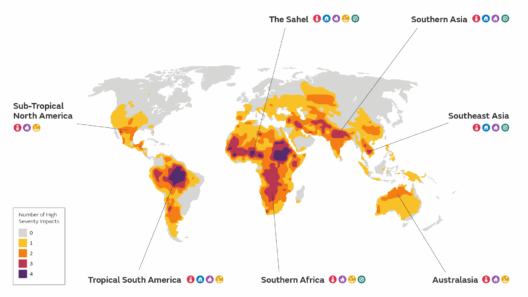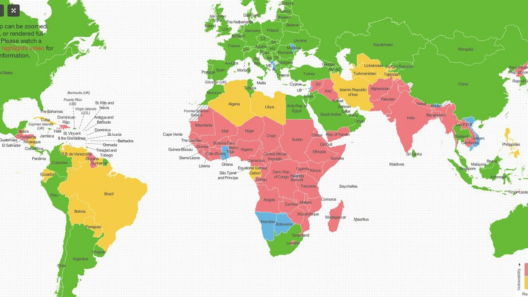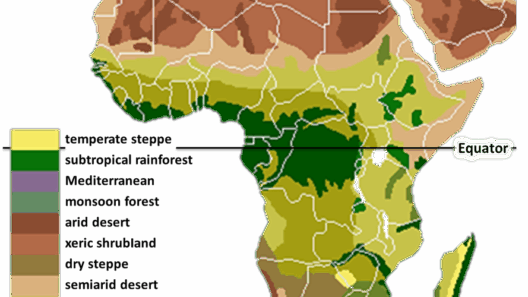The intricate dance of climate, much like a finely woven tapestry, is influenced by a multitude of factors that interplay in a complex manner. Understanding these factors is imperative for grasping the nuances of our planet’s climate systems. Here, we will delve into five paramount influences on climate: latitude, altitude, ocean currents, topography, and human activity. Each factor possesses its own unique flair and consequences, subtly yet profoundly shaping the climate we experience.
1. Latitude: The Earth’s Solar Embrace
Latitude serves as the defining parameter of warmth across our globe. Positioning on the north-south axis governs the amount of solar energy received by a region. The equator, basking in the sun’s relentless embrace, experiences consistent and intense solar radiation throughout the year. Conversely, regions located near the poles receive sunlight at a slanted angle, leading to lower temperatures.
Consider the lush rainforests of the Amazon and the arid expanse of the Sahara. The Amazon thrives under a tropical climate, heavily influenced by equatorial latitude, which provides abundant precipitation and temperate weather year-round. In stark contrast, the Sahara’s subtropical latitude ensures its reputation as one of the hottest deserts on the planet, with scant rainfall marking its yearly calendar.
This latitude-climate relationship elucidates how solar elevation shapes regional ecosystems, phenology, and ultimately the distinctly different biomes we encounter around the world.
2. Altitude: Climbing the Atmospheric Ladder
The altitude of a region adds another dimension to climate formation. As one ascends into the sky, temperature tends to decrease. This phenomenon is due to the thinning atmosphere, which is less capable of trapping heat. Therefore, even in regions where lowlands may be sweltering, high-altitude areas can experience frigid temperatures.
A case in point is the Himalayas, where the towering peaks create a microclimate that fosters diverse ecosystems—from tropical vegetation in the foothills to tundra conditions on the summits. The drastic temperature elevation impacts not only local weather patterns but also global climatic trends, influencing monsoon systems and glacial melt cycles.
Understanding altitude’s effect on climate reveals how mountainous regions can act as barriers to climatic transitions and how they embody unique weather phenomena that can radically differ from their surrounding lowlands.
3. Ocean Currents: The Earth’s Thermostat
Ocean currents function as colossal conveyer belts, transporting heat across vast distances and significantly affecting the climate of coastal regions. The interplay of salt concentration, temperature variations, and wind patterns orchestrates the movement of these vast water bodies, akin to the rhythmic ebb and flow of a seamless tide.
The Gulf Stream, for instance, allows warm water to move from the Gulf of Mexico across the Atlantic, contributing to milder winters in Europe than one might anticipate at such latitudes. Conversely, cold currents like the California Current cool the air above, resulting in milder climates along the Californian coast.
Through the lens of oceanic influence, we can appreciate how the connectivity of our global waters shapes not only marine environments but also terrestrial climates, acting as a stabilizing force that upholds weather patterns across continents.
4. Topography: The Earth’s Sculptural Design
The Earth’s diverse topography serves as a grand sculptural design, wherein mountains, valleys, and plains forge distinct climatic conditions. Elevation changes create rain shadows and modify wind currents, resulting in climate variation even within short geographical distances.
For example, the Cascade Range in the Pacific Northwest exemplifies this phenomenon. The western slopes, which face the prevailing westerly winds, are drenched with moisture, resulting in lush temperate rainforests. In contrast, the eastern side is left arid and dry, forming a stark rain shadow and leading to the development of a desert-like landscape.
Through these geographic peculiarities, topography profoundly influences local ecosystems and human habitation while unveiling the diverse climates that emerge from this three-dimensional interplay.
5. Human Activity: The Anthropogenic Catalyst
In recent decades, human activity has emerged as a formidable factor impacting climate. Industrialization, urbanization, and deforestation are just a few of the ways in which modern civilization alters atmospheric conditions and disrupts natural cycles. The release of greenhouse gases into the atmosphere from fossil fuels is likened to a thick blanket being draped over the Earth, trapping heat more efficiently and prompting global warming.
The melting ice caps, rising sea levels, and the increasing prevalence of extreme weather events serve as harbingers of climate change, rooted in anthropogenic actions. Urban heat islands illustrate how cities, often laden with concrete and asphalt, create localized areas of increased temperature, influencing weather patterns well beyond their boundaries.
The significance of human activity cannot be overstated, as it plays a pivotal role in shaping the trajectory of climate change and poses challenges for future sustainability. Recognizing our impact leads to an urgent call for mitigating strategies to ameliorate further damage to our intricate climate system.
Conclusion
In summary, climate is a multifaceted entity governed by numerous influences, each contributing to the broader narrative of our planet’s ecological health. Latitude, altitude, ocean currents, topography, and human activity create a complex symphony that determines the climates of our world. A deeper understanding of these elements fosters a greater appreciation of the environment we inhabit, instilling the urgency to protect both our planet and its delicate climate. The climate’s story is not stagnant; it is continuously unfolding, marked by the interplay of natural forces and the choices we make in shaping our future.








